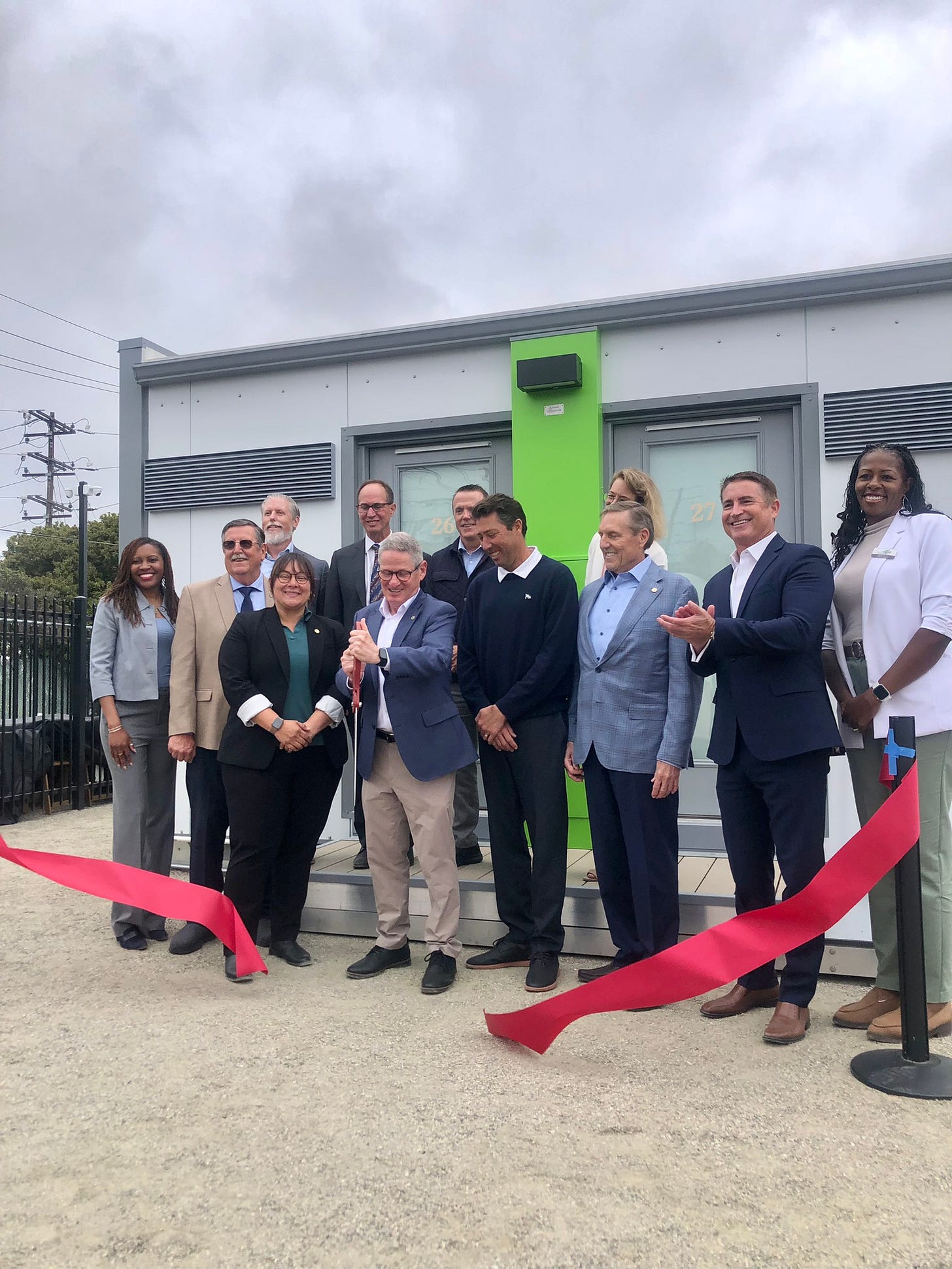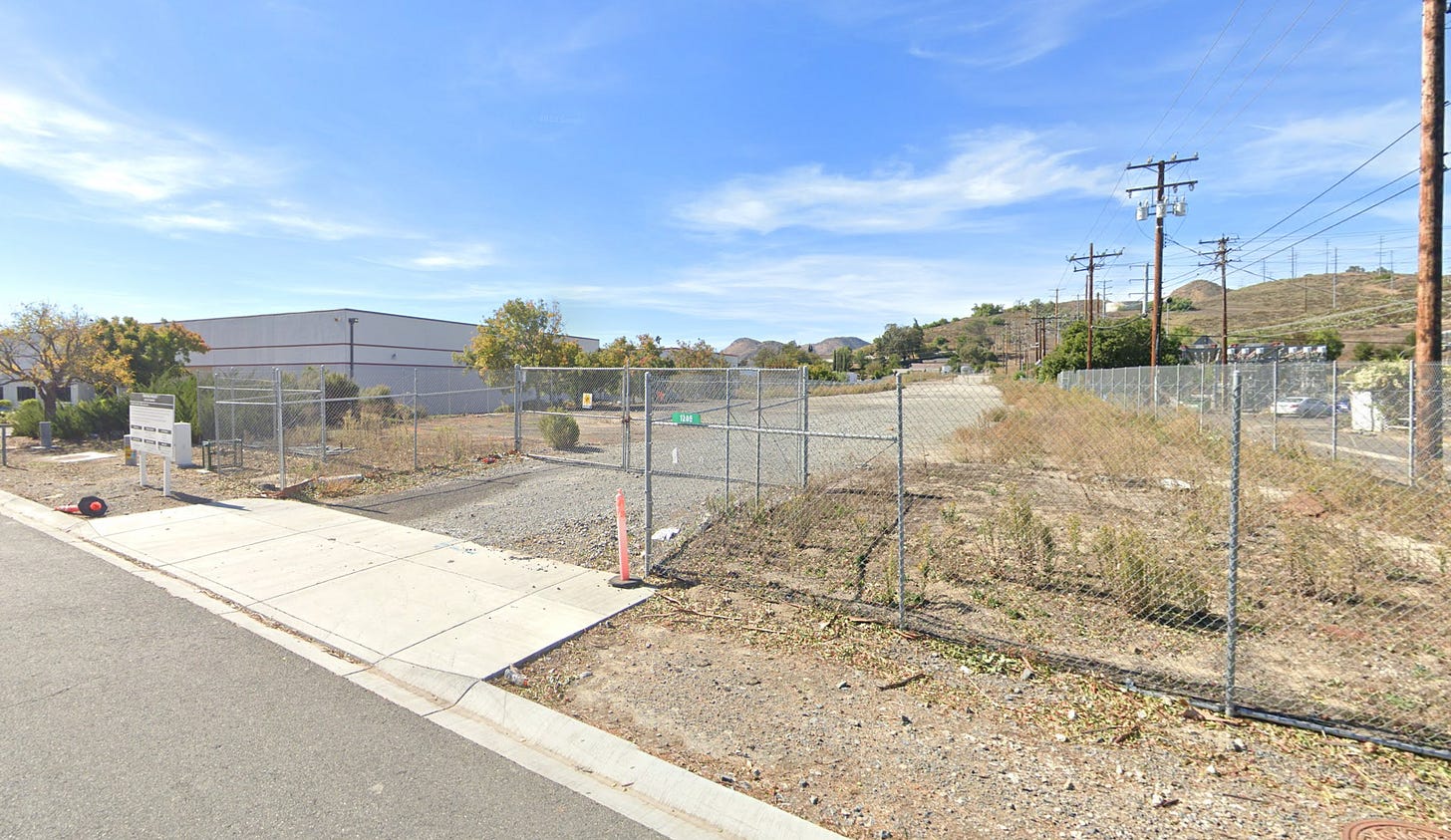Field Trip to Thousand Oaks
A look at TO's ERF-funded interim supportive housing project. Plus: Political updates, federal and hyperlocal.
Greetings Readers!
While we await a proposed development agreement for Ojai’s 30-unit state-funded permanent supportive housing project for homeless community members, let’s zoom out.
On Wednesday, I took a field trip to Thousand Oaks for the ribbon cutting of the City’s new Encampment Resolution Fund-supported interim housing project.1 The 30-unit “navigation center” will temporarily house individuals from one of three Thousand Oaks encampments. The facility will also provide wrap-around services like meals, laundry, case management, behavioral health referrals, job training and access to treatment programs, said Thousand Oaks Mayor David Newman.
The development, now known as Thrive Grove, was constructed by Dignity Moves, the group behind Ojai’s Cabin Village. Thousand Oaks was awarded $5.8 million in ERF funding in August 2023 (eight months ahead of Ojai). They received the full amount requested.
Thrive Grove is located on a City-owned parcel in an industrial area. An hourly shuttle service will connect residents with public transportation.
“We looked at several properties,” explained Dusty Russell, an Economic Development Analyst for the City of Thousand Oaks. “We did focus on city-owned properties mostly because the real estate is just very cost-prohibitive.”
Thrive Grove’s closest neighbor is a business park. “It's fair to say that [neighbors] were initially concerned, but our leadership sat down with them and explained the ins and outs, [it’s an] operation that's referral-based only,” Russell said. “There's not going to be folks hanging out outside of the facility, that sort of thing.”
I had the opportunity to walk through the development May 7th — I invite readers to take a little tour of Thrive Grove in the videos below.
(Click here to skip to the rest of the story.)
Tour complete!
The ceremonial ribbon cutting took place after some political commentary and uplifting remarks — standard stuff for a press event celebrating public funding.
“I have to admit to being initially skeptical of this particular location because of all the investment that was needed,” acknowledged Andrew Powers, the Ben Harvey of Thousand Oaks. “This was just raw city land here, no water, no wastewater, no utility infrastructure.” He credited his Assistant City Manager, Ingrid Hardy (Thousand Oaks’ Carl Alameda) with the location choice.
Mayor Newman said the project represents a prudent investment.
“The status quo takes a terrible toll, not just on our unhoused neighbors, but also on our police, healthcare, social services and social justice systems, and criminal justice systems. What we are doing here today is caring and compassionate. Yes, but it's also the responsible thing to do.”
Meet the Team: Ken Craft, Hope the Mission & Many Mansions
Hope the Mission is a non-profit organization that works with 26 interim housing facilities like Thrive Grove, CEO Ken Craft said.
Craft initially grabbed my attention with his political commentary:
“When I was first introduced to the [Thrive Grove] team… If I'm honest, I'm thinking, ‘seriously, Thousand Oaks? Are you serious?’ But I didn't say that because I never want to be disparaging to anyone, but I'm thinking ‘Seriously?’ And only because usually higher net worth areas tend to foster more NIMBYism. Okay? Just keeping it real.”
We can think of Hope the Mission’s role at Thrive Grove as similar to HELP of Ojai and Ventura County Behavioral Health’s planned roles at a future Ojai Cabin Village — they’re present on site, connecting residents with services.
Case managers, security services (via Good Guard), and “client service monitors” will be on-site daily, Craft explained. Client service monitors will be the folks working closest with residents, he said. These employees, in short, are making sure rules are followed2, bathrooms are cleaned, and meals are served. (There will be three meals a day for residents, Craft said.)
Then he told a story that kind of knocked me out.
“Like many of you, I was born here in Ventura County, in Ventura. I lived in Thousand Oaks and Simi Valley. My kids went to Thousand Oaks High School… I've never been unsheltered a day in my life. I've always had a home. I've always had a refrigerator that I could get food and whatever I needed, but I wanted to put myself in someone else's shoes for just a moment. So myself and the president of [Hope the Mission] we decided to live homeless [for] 100 hours on the streets of Los Angeles. Unsheltered in December, [a] Pacific storm coming in, temperatures getting down to 38 degrees, with $5 to my name and a backpack. I was sent out in the middle of the rain in a van, dropped off in undisclosed location and [they] said, ‘God bless you.’”
Craft’s four-day odyssey is documented below. It’s intense.
Craft and Hope the Mission President and CFO Rowan Vansleve periodically undertake these challenges as fundraising missions. The duo recently completed a walk that Craft called “the long walk home,” — from Seattle to Los Angeles. And when I say recently, I mean they arrived back in L.A. in late April.
During the journey, Craft and Vansleve each walked 12 hours a day, then switched places on an RV following behind.
“I got a stress fracture probably in Oregon,” Craft recounted casually. “Then when I got just outside of Bakersfield, I actually broke the bone in two. And so I ended up walking from Bakersfield to LA with a broken bone.” I asked how he managed.
“It was a campaign called the Long Walk Home,” he said. “And it was an emphasis on what happens when someone makes a [tough] decision. [Like], I'm going to end my addiction. In homelessness, it's a long walk home.”
Rick Schroeder, CEO of the non-profit Many Mansions, came to the podium next, joking that he often has the distinct misfortune of following Craft in the speaking order.
Many Mansions, Schroeder said, is the leading provider of permanent supportive housing in Ventura County. Right now, they manage approximately 200 units, with projects on the way in Camarillo, Oxnard, and Fillmore. Some of those units are reserved for chronically homeless individuals like those who will move through Thrive Grove, he said.
(This piece is critical consideration here in Ojai — the reason that the City could not have constructed an interim shelter like Thrive Grove with ERF money is that Ojai has no existing permanent supportive housing units. Because what’s the point of interim housing that doesn’t lead to a home?)
Schroeder and colleagues’ role at Thrive Village is managerial — they’re the group that connected the City of Thousand Oaks with Dignity Moves and Hope the Mission. “We're assisting Hope the Mission to make sure they're keeping track of things and people are moving in, moving out, all that sort of stuff,” Schroeder explained. “We’re the ones answerable to the City and the County.”
I asked Craft what happens if someone is ready to move on from Thrive Grove, but there’s no permanent supportive housing available — waiting lists are a known issue.
“What we tell people is, your next stop is permanent housing,” he said. “We're not going to give up on you until we get you to permanent housing.”
Dignity Moves’ Founder and CEO Elizabeth Funk came last in the speakers’ program. (Exciting, no?)

“I think the biggest thing standing in the way to ending homelessness is that we don't think it's possible. It's very possible,” Funk declared. “This is the beginning that starts to show that it is possible… Ending unsheltered homelessness entirely in this city is not a far away hurdle. Another couple hundred people. And you could really declare victory over this shameful curse on our conscience and on the lives of people.”
The Money
Now the fun part — let’s talk about the money.3
According to Thousand Oaks Assistant City Manager Ingrid Hardy, construction of Thrive Grove cost approximately $8.5 million. The City used $4.1 million of its $5.8 million in ERF dollars for construction, she said. According to Hardy, the County and City will contribute equally to the remaining construction balance ($4.4 million total, or $2.2 million each).
“At the start of the project, the County agreed to contribute up to $2 million for construction. We anticipate that county staff will request approval from their board for an additional contribution,” Hardy said.
First year operating costs for Thrive Grove, Hardy said, are estimated at $1.2 million. The City is utilizing $835,000 in ERF dollars for year one operations, she said. According to Hardy, the City and County will contribute equally to the remaining balance. (That would be $182,500 each.)
Readers can get a little more specificity from the City’s initial project budget. The City didn’t meaningfully change its budget after submitting its ERF application to the state, Hardy confirmed.
Not so for little Ojai!
Back Home
The California Department of Housing and Community Development (the agency administering the ERF program) confirmed that the City of Ojai submitted an ERF budget change request to the state on April 30, 2025, which is currently under review.
The biggest proposed changes include:
Approximately $450,000 more dollars allocated toward Cabin Village operating costs.
Approximately $450,000 fewer dollars toward “delivery of permanent housing.” (The change order estimates the “delivery of permanent housing” to cost $9.9 million, down from the original $10.4 million.)
Approximately $100,000 more dollars allocated for a service contract with Ventura County Behavioral Health. (This cost will be split between the City’s General Fund and the ERF grant dollars.)
And the elimination of a $1.1 million line item from the original budget, which was intended for property acquisition.
The full project budget remains unchanged: $12,667,461.04
As discussed in a previous story, the next likely steps for the Cabin Village project will be a) a Council vote on a final development agreement with Dignity Moves, and b) the provision of a multi-million dollar check to the developer.
Now, thanks to an April 26th memo from Ojai City Manager Harvey to the City Council (first made public by Kim Rivers of the Ojai Valley News 👏) we’ve learned that the Cabin Village design, as agonized over by the Planning Commission, could pivot to a “modular construction approach.” Harvey blamed tariff uncertainty and price increases for the pivot.
In a May 2nd memo from Harvey — also first reported by Rivers — the Council received a bit more news.
There are a few critical details here:
Dignity Moves agreed to cap its costs at $9.5 million — this roughly corresponds with what we saw in the budget change order.
Harvey states “Dignity Moves remains interested in a cob construction method for the project.”
Finally: the City Council will discuss the Dignity Moves development agreement at the May 27th City Council meeting. And “a detailed budget will be delivered to the City” within ninety days of “anticipated approval of the development management agreement…”
I checked in with Ojai Mayor Andy Gilman on the issue of cob construction vs. modular construction:
“Whatever comes before the Council, it has to be in line with what the community agreed to… Part of what made the citizens of Ojai interested in this project was its innovative [construction] aspects. I’m committed to that,” Gilman said.
To Washington, D.C.
Before we close, we should talk about the President Trump’s 2026 Budget Request to Congress.
The letter preceding the budget request, from White House Office of Management and Budget Director Russell T. Vought4 is quite the document.
In Vought’s telling, “funding [for] niche non-governmental organizations and institutions of higher education committed to radical gender and climate ideologies antithetical to the American way of life,” must be cut in order “to ensure that our military and other agencies repelling the invasion of our border have the resources needed to complete the mission.”5
To state the obvious: this budget looks like that of a nation going to war.
Vought’s letter to Congress encourages significant cuts at the U.S. Department of Housing and Urban Development (recall the voucher discussion in my last story.) Specifically, the President’s proposed budget cuts support for permanent supportive housing programs, which are administered through organizations like the Ventura County Continuum of Care (COC). (Remember: we have the Ventura County COC Program Director Jennifer Harkey to thank for writing Ojai’s ERF grant application.)

“The proposed federal cuts would be detrimental to our local safety net programs, especially our CoC Permanent Supportive Housing (PSH) for those living with disabling conditions,” Harkey wrote via email. “The proposal includes HUD grant cuts of $33.5 billion or 44% by limiting assistance to short term services. While this is still only a proposal from the White House, we are encouraging our CoC Board and stakeholders to reach out to local legislators to advocate for the continuation of these safety net programs.”
I’m reminded of this sentence from the Ventura County COC’s most recent Point in Time Count of homeless community members, celebrating the County’s drop in homelessness:

Moving along — we touched on the importance of federal housing vouchers (or Section Eight funding) to the City’s Cabin Village cost mode in a past story. That funding stream, too, is in danger.

I asked Rick Schroeder of Many Mansions how those cuts could impact his work.
“We rely on those section eight rents, which are much higher than we would charge somebody [in rent],” he explained. “[For example] someone's homeless, they [pay] 30% of their income. They're paying us, what, $400 or $500 a month. They get a section eight voucher, instead of paying us $500 a month, we receive $2,000 [from the federal government]. And that helps pay for those properties. Operations, the electricity, utilities, everything.
“And that's why I think it's not likely to be cut,” Schroeder continued. “Because every city in this country, every mayor, every city council supports this. And if it's cut or eliminated, we the amount of people that would be homeless would skyrocket. And what city wants to deal with that? So politically, I think there's a lot of opposition against that.
But even a 10% cut would hurt us. Would definitely hurt us.”
That is where I’m going to leave us for today, folks. As always, thank you for spending time with me. Put May 27th on your calendar.
Thank you to paid subscribers for supporting this work. You literally bought my gas.
What are the rules? I was curious too! Here’s Ken Craft, “there's no drugs, there's no alcohol, no weapons allowed inside. There's rules on taking care of their pet if they have one... [No] cooking, no flammable candles or anything inside the unit, and you're not going to go in anyone else's unit.”
This is, of course, a joke.
He also played a major role in drafting Project 2025.
I have to note for readers that documents coming out of the Trump White House often contain basic misstatements of fact and blatant prejudice. That’s just what it is.





